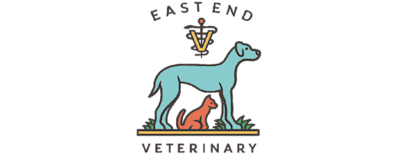East End Veterinary Medical Centre

Dog Hygiene and Training

Dog Nail Trims
If your dogs toenails are white you can seethe reddish/pinkish color in them. That is called the Quick. The quick is the blood supply that’s in the nail that goes to the foot. If you would cut the nail too short and nick the quick, the dog might yelp because it is painful. If you nick the quick and the nail starts to bleed, you can either use “Kwik Stop” (can be purchased at any pet store) or make a paste out of flour and water, and pack it into the nail where the bleeding is.
If your dog has black toenails, then seeing the quick is not an option. The only thing you can do in this case is to cut off a small piece at a time. As you are trimming the nail, look at the bottom of it. The light tissue is the curved bottom part of the nail. The mottled light and dark tissue is the top part of the nail.
As you cut deeper, you will see a homogenous gray to pink oval starting to appear at the top of the cut surface of the nail. Stop cutting the nail at this point. If you continue to cut, you will hurt your dog and make them bleed.

Tips
The sharper the trimmers, the cleaner the cut.
You can file the end of the nail to smooth the rough sharp edges or take your dog for a walk on cement.
Walking on cement might help grind down nails and allow for more time between each trim.
When your dog is a puppy you will want to play with their paws and hold them so that they get used to people touching them. This makes it easier for them to adjust to people trimming their nails.

House Training
“Accidents” are one of the most common reasons people give up their dogs. Ironically, house training is very simple with the proper tools and instructions.
The more patient and consistent you are in teaching your pup basic house training procedures, the more quickly he/she will learn acceptable behavior. It may take several weeks to house train your puppy, and with some of the smaller breeds, it might take longer. Dogs are instinctively clean animals and will learn quickly with the proper guidance. Dogs who have “accidents” may have never been taught properly, or they may have spent time in a shelter or a previous home that had a different routine.
Establish a routine. Feed your puppy at regular scheduled times, preferably 3 times a day. Most puppies will want to relieve themselves right after eating (their lower bowels are stimulated each time they eat). Do not allow access food all day long.
Go outside with your puppy so you can praise him/her for going potty outside. At a minimum, take him/her out first thing in the morning, after each meal, and right before bedtime.
Choose 1 or 2 “bathroom areas” your dog can associate with going potty. Direct your puppy to these areas and when he’s/she’s there, give a command like “hurry up”. When your puppy goes to the bathroom, lavishly praise his/ her success so he/she associates outside potty time with treats and praise for a job well done.
Keep your eyes on your puppy while he’s/she’s inside the house. If you catch him/her in the act, shout or toss something soft (a toy or a slipper) NEAR, not directly at him/her to startle him/her. Then immediately take him/her outside and if he/she goes potty outside, then praise him/her for doing the right thing.
Expect a few accidents. Like children, it will take sometime for your new puppy to learn. Puppies cannot be expected to control their bladder for more than a few hours at a time.

Do not punish accidents. Punishing only makes matters worse because your dog won’t understand what he/she did wrong (even if you rub his/her nose in it!!!! – This is a big NO NO). Do not punish or yell at puppies if they had an accident and you didn’t catch them in the act. They don’t know what they did wrong, and they think that you're yelling at them for no reason. They only know they did something wrong if, at that moment while in the act, you see them doing it then you can yell. NEVER HIT AN ANIMAL!!!
